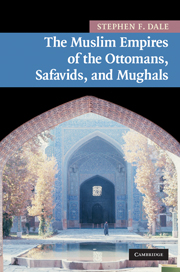Book contents
- Frontmatter
- Contents
- List of illustrations
- List of maps
- Preface
- Languages and transliteration
- Introduction
- 1 India, Iran, and Anatolia from the tenth to the sixteenth century
- 2 The rise of Muslim empires
- 3 The legitimacy of monarchs and the institutions of empires
- 4 The economies around 1600
- 5 Imperial cultures
- 6 Golden ages: profane and sacred empires
- 7 Imperial culture in the golden age
- 8 Quests for a phoenix
- Conclusion
- Glossary
- Dynastic lists
- Bibliography
- Index
6 - Golden ages: profane and sacred empires
Published online by Cambridge University Press: 05 October 2014
- Frontmatter
- Contents
- List of illustrations
- List of maps
- Preface
- Languages and transliteration
- Introduction
- 1 India, Iran, and Anatolia from the tenth to the sixteenth century
- 2 The rise of Muslim empires
- 3 The legitimacy of monarchs and the institutions of empires
- 4 The economies around 1600
- 5 Imperial cultures
- 6 Golden ages: profane and sacred empires
- 7 Imperial culture in the golden age
- 8 Quests for a phoenix
- Conclusion
- Glossary
- Dynastic lists
- Bibliography
- Index
Summary
Introduction
In Greek mythology a golden age may have been conceived of as a utopia of social harmony, political stability, prosperity, and peace, a kind of Arcadia, but when it comes to dynastic politics, golden ages tend to be defined as periods of imperial domination and cultural florescence. Often the idea of a golden age consists of little more than nostalgia for an imagined and imaginary past; but in some cases the elite members of a society, who share an intoxicated sense of their power, privilege, and prestige, acclaim their own age as a climactic moment in the history of their civilization. In the case of the Muslim empires, the Ottoman Sultan Süleyman and the Mughal Padishah Shah Jahan presided over what they and also many of their descendants believed to be an apogee in the history of their own dynasty and, in the Ottoman case, its place in the broader Islamic world. While their respective reigns were as different as the geographic and cultural context and political character of the states they inherited, both men made new claims for their legitimacy, and patronized spectacular architectural projects that seem to ratify their imperious self-images and ensure the favorable verdicts of posterity. The most notable of these structures were the sixteenth-century mosque complexes of the Ottoman imperial architect Sinan, and the seventeenth-century Taj Mahal and Shah Jahan's new imperial city in Delhi.
- Type
- Chapter
- Information
- The Muslim Empires of the Ottomans, Safavids, and Mughals , pp. 177 - 207Publisher: Cambridge University PressPrint publication year: 2009



